Dallas/Fort Worth International Airport, also known as DFW Airport, is the primary international airport serving the Dallas–Fort Worth metroplex area in the U.S. state of Texas.
It is the largest hub for American Airlines, which is headquartered near the airport. It is the fourth busiest airport in the world by aircraft movements and the fifteenth busiest airport in the world by passenger traffic in 2017.
It is the ninth busiest international gateway in the United States and the second busiest international gateway in Texas. American Airlines at DFW is the second largest single airline hub in the world and the United States, behind Delta’s Atlanta hub.
In 2019, DFW set a new passenger traffic record in its 45 year history, serving 75,066,956 passengers.
Located roughly halfway between the major cities of Dallas and Fort Worth, DFW spills across portions of Dallas and Tarrant counties, and includes portions of the cities of Irving, Euless, Grapevine and Coppell.
At 17,207 acres (6,963 hectares; 27 square miles, 69.6 km² ), DFW is larger than the island of Manhattan, and is the second largest airport by land area in the United States, after Denver International Airport.
As of January 2020, DFW Airport has service to 260 destinations, including 67 international and 193 domestic destinations within the U.S. In surpassing 200 destinations, DFW joined a small group of airports worldwide with that distinction.
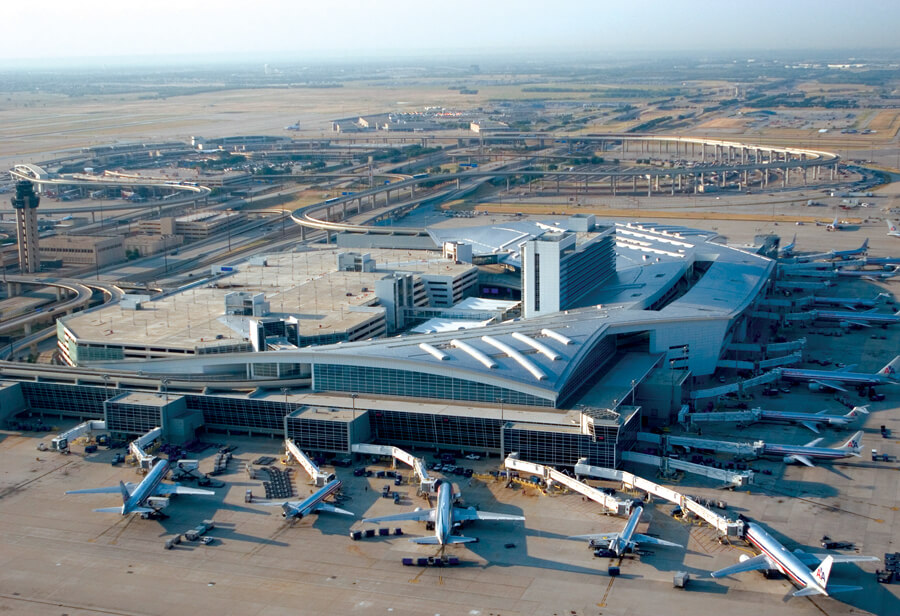
History
Planning
In 1940 the Civil Aeronautics Administration earmarked $1.9 million for the construction of a Dallas/Fort Worth Regional Airport.
The joint airport proposal was revisited in 1961 after the Federal Aviation Administration (FAA) refused to invest more money in separate Dallas and Fort Worth airports.
Under the original 1967 airport design, DFW was to have pier-shaped terminals perpendicular to a central highway.
In 1968, the design was revised to provide for semicircular terminals, which served to isolate loading and unloading areas from the central highway, and to provide additional room for parking in the middle of each semicircle.
The plan proposed thirteen such terminals, but only four were built initially.
The land was purchased by the cities in 1966 and construction began in 1969.
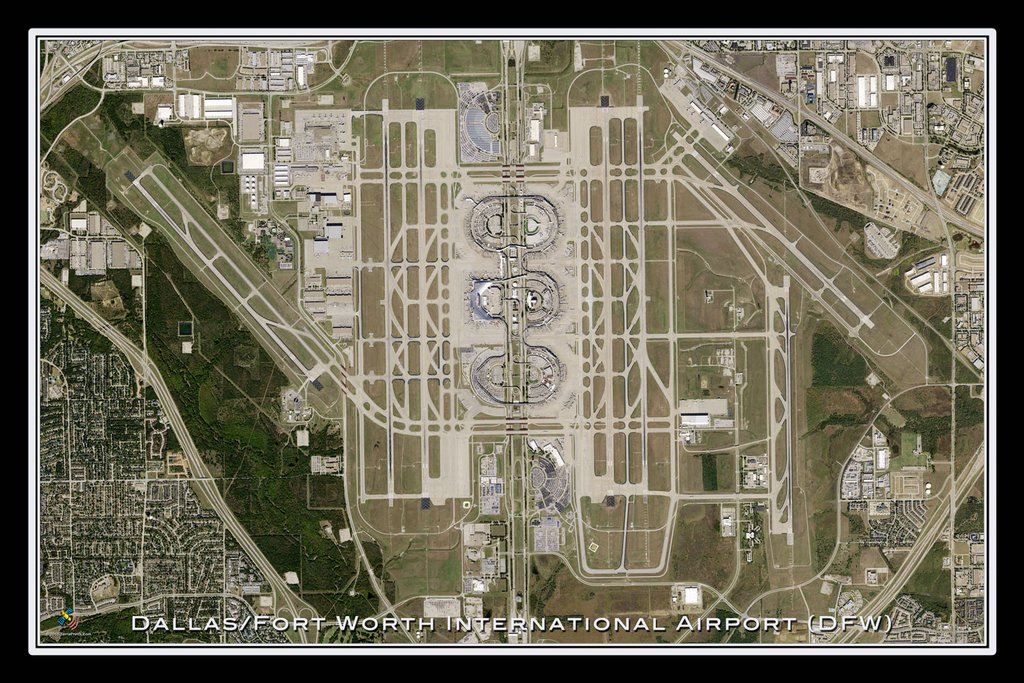
Opening and operations
DFW held an open house and dedication ceremony on September 20–23, 1973, which included the first landing of a supersonic Concorde in the United States, an Air France aircraft en route from Caracas to Paris.
The airport opened for commercial service as Dallas/Fort Worth Regional Airport on January 13, 1974, at a cost of $700 million.
The name change to Dallas/Fort Worth International did not occur until 1985.
When it opened, DFW had four terminals, numbered 2W, 2E, 3E and 4E.
In 1989 the airport authority announced plans to rebuild the existing terminals and add two runways.
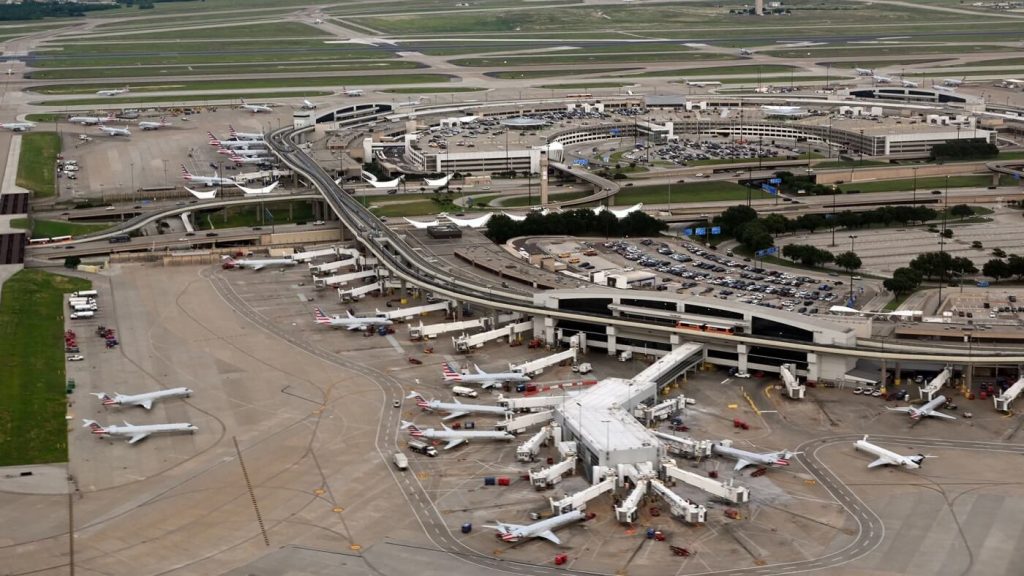
The seventh runway opened in 1996.
The 4 primary north–south runways (those closest to the terminals) were all lengthened from 11,388 feet (3,471 m) to their present length of 13,400 feet (4,084 m).
The first, 17R/35L, was extended in 1996 (at the same time the new runway was constructed) and the other three (17C/35C, 18L/36R and 18R/36L) were extended in 2005.
DFW is now the only airport in the world with 4 serviceable paved runways longer than 4,000 metres (13,123 ft).
Terminal D, built for international flights, and DFW Skylink, a modern bidirectional people mover system, opened in 2005.
Airports Council International (ACI) named DFW Airport the best large airport with more than 40 million passengers in North America for passenger satisfaction in 2016.
In June 2018, DFW Airport opened a fully functioning emergency room on airport grounds, located in Southgate Plaze near the Airport Headquarters and Rental Car Center.
With this opening, the facility became the first actual ER on an airport’s property anywhere around the globe.
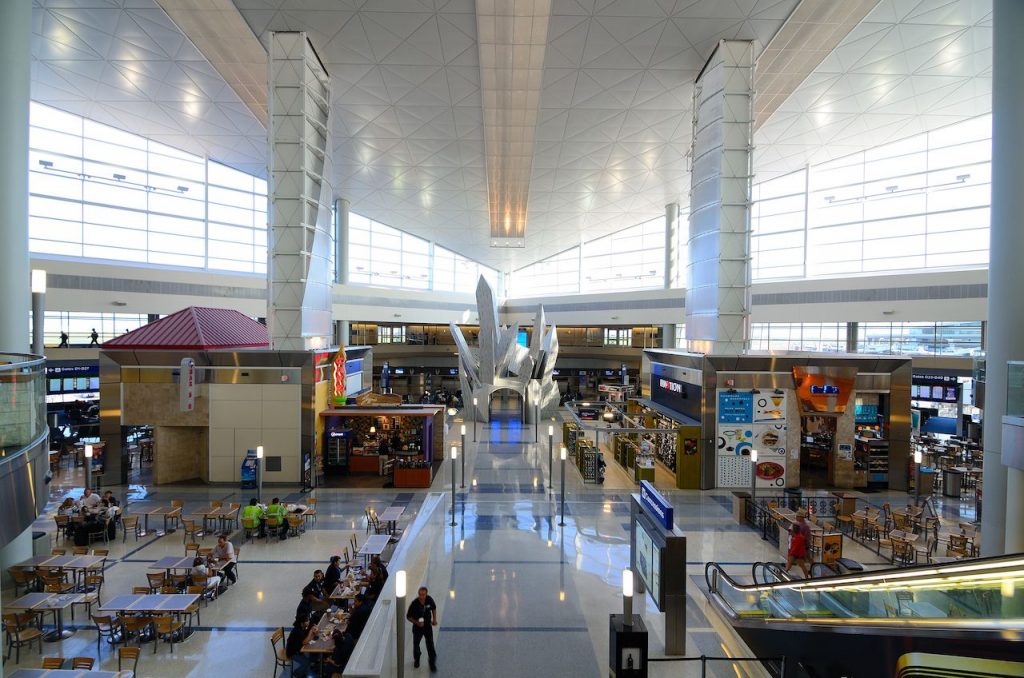
Terminals and facilities
Dallas/Fort Worth International Airport has five terminals and 182 gates.
The airport is designed with expansion in mind and can theoretically accommodate up to 13 terminals and 260 gates, although this level of expansion is unlikely to be reached in the foreseeable future.
The terminals at DFW are semicircular (except for the newest terminal, Terminal D, which is a “square U” shape) and built around the airport’s central north–south arterial road, International Parkway. Until the late 1990s, they were designated by a number (2 being northernmost, 4 being southernmost) and a letter suffix (“E” for East, “W” for West).
This system was later scrapped and the terminals are now lettered from A to E. Terminals A, C, and E (from north to south) are on the east side of the airport, while Terminals B and D (from north to south) are on the west side.
DFW’s terminals are designed to minimize the distance between a passenger’s car and airplane, and to reduce traffic around terminals. A consequence of this layout is that connecting passengers had to walk extremely long distances between gates (in order to walk from one end of the semicircular concourse to the other, one must walk the entire length; there were no shortcuts or moving walkways between the ends).
It was replaced by Skylink in April 2005 after serving approximately 250 million passengers. Skylink serves all five terminals at a considerably higher speed (up to 35 mph (56 km/h)), is bi-directional, and is located inside the secured area.
Terminal Link connects all terminals with a shuttle bus system on the non-secure side.
DFW Airport tentatively completed a $2.7 billion “Terminal Renewal and Improvement Program” (TRIP), which encompassed renovations of three of the original four terminals (A, B, and E).
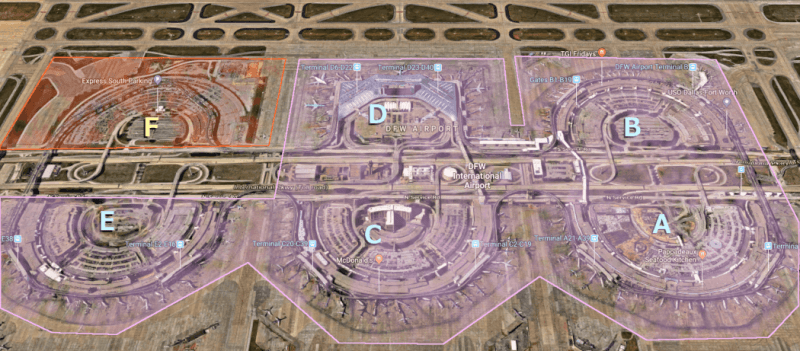
Work on the project began following the conclusion of Super Bowl XLV in February 2011. Terminal A was the first terminal to undergo these renovations which were completed in January 2017 at a cost of about $1 billion.
This was followed by the completion of Terminal E in August 2017 and Terminal B in December 2017.
While Terminal C was originally part of the multibillion-dollar renovations, American Airlines in 2014 asked to delay renovations of the terminal.
Terminal C is now slated to be renovated along with the project to construct a new terminal, Terminal F, to be completed sometime in 2025.
Terminal A
Terminal A has 26 gates. Originally named “Terminal 2E”, it is fully occupied by American Airlines for domestic flights and some international departures.
Prior to the opening of Terminal D, Terminal A operated most of American Airlines’ international flights at the airport.
A satellite terminal near Terminal A was used due to gate restraints. Passengers were taken to the satellite via shuttle buses from gate A6. The satellite terminal was abandoned in 2005 when all American Eagle flights were consolidated into Terminals B and D.
It now serves as a Corporate Aviation terminal for private and corporate aircraft, reopening in December 2010.
As of January 2017, renovations in Terminal A are now completed.
Terminal B
Terminal B has 47 gates.This terminal was called “Terminal 2W” when the airport was opened.The terminal contains an American Airlines Admirals Club.
Along with the TRIP improvements, a new 10-gate stinger concourse off of Terminal B was constructed between gates B28 and B33 to accommodate growth.
The stinger concourse makes Terminal B the largest terminal at DFW in terms of number of gates.
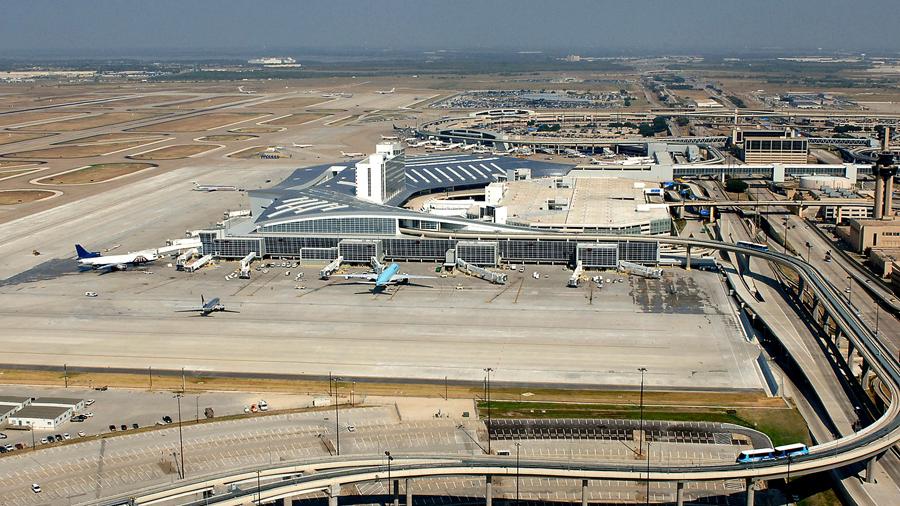
Terminal C
Terminal C has 28 gates. American Airlines operates all the gates at Terminal C, originally called “Terminal 3E”, for only domestic flights. The terminal contains an American Airlines Admirals Club.
Announced on May 20, 2019, Terminal C will be renovated along with the project to construct a new terminal, Terminal F, both to be completed by 2025.
Terminal D
Terminal D has 26 gates. It is DFW’s international terminal, capable of handling 32,000 passengers daily or 11.7 million passengers annually. All international flights without border preclearance arrive in Terminal D.
The terminal features 200 ticketing positions and a federal inspection facility capable of processing 2,800 passengers per hour. The terminal officially opened on July 23, 2005.
The eight-level parking garage has over 8,100 parking spaces and uses a Smart Technology System that lets guests know which floors are full.
Air-conditioned skybridges with moving walkways and elevators connect the garage to the terminal, and an arrivals canopy roof shields pedestrians from inclement weather as they enter and exit the terminal. The 298-room Grand Hyatt DFW Hotel is directly connected to the terminal.
In addition, Terminal D hosts a Minute Suites hotel located inside security. The terminal contains an American Airlines Admirals Club, a British Airways Lounge, a Korean Air Lounge, a Lufthansa Lounge, and a Qantas Business Lounge and an American Express Centurion Lounge.
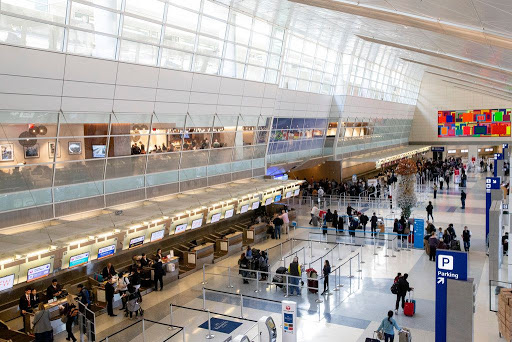
Terminal E
Terminal E has 41 gates.
Terminal E is distinctive in that it has a satellite terminal connected by an underground walkway. The satellite, opened in 1988 to accommodate Delta and was later used by Delta Connection.
It was briefly used in 2009 to house federal workers who evacuated New Orleans International Airport during Hurricane Gustav. It was refurbished and reopened in 2013 to house US Airways and Spirit Airlines while Terminal E was renovated.
In April 2018, DFW Airport and American Airlines announced a $20 million renovation to the satellite terminal, which converted 9 existing mainline gates to 15 regional gates, along with updating interior fixtures such as carpet, elevators, escalators and moving walkways. American planned to have renovations completed by then and was fully moved into the terminal on May 3, 2019.
Future
On May 20, 2019, DFW airport, along with American Airlines, announced plans to build a 6th terminal. The proposed project is estimated to cost $3–3.5 billion and was expected to finish as soon as 2025.
Along with the addition of up to 24 new gates to Terminal F, renovations of Terminal C are planned to take place, as it is the last terminal which has not been updated in recent years.
However, due to the COVID-19 pandemic, the timing of the project is currently in flux.
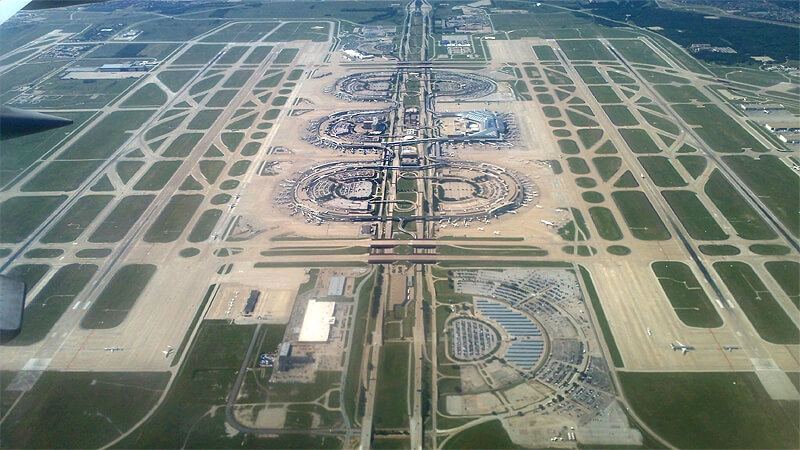
Dallas/Fort Worth International Airport Data
- Country
- America
- Region
- North America
- Status
- In use
- Location
- Dallas and Tarrant counties, Texas
- Owner(s)
- Cities of Dallas and Fort Worth
- Official website
- dfwairport.com
- Operator(s)
- DFW Airport Board
- Began
- 1969
- Opened
- Sep-23, 1973
- Airport type
- Public
- Airport code
- IATA: DFWICAO: KDFWFAA LID: DFWWMO: 72259
- Airport area
- 17206 acres / 69.63 km²
- Runway length
- 4*4085 m,1*2590 m,1*2743 m,1*2834 m
- Navigable city
- 260 (2020)
- Passenger traffic
- 75 million(2019)
- Freight volume
- 984,850 tons (2019)
- Takeoffs and landings
- 720,007 sorties (2019)
View Dallas/Fort Worth International Airport on Google Satellite Map
Google satellite maps allow you to see building details more clearly, including natural landscapes such as mountains, rivers, deserts, sea and man-made engineering buildings.
If you are very interested in this engineering building, it is a good idea to click below Google Map icon. We will help you jump to the corresponding location of this building or engineering on Google satellite map.































































[…] https://www.reduper.com/industry/traffic/airport/dallas-fort-worth-international-airport/ […]